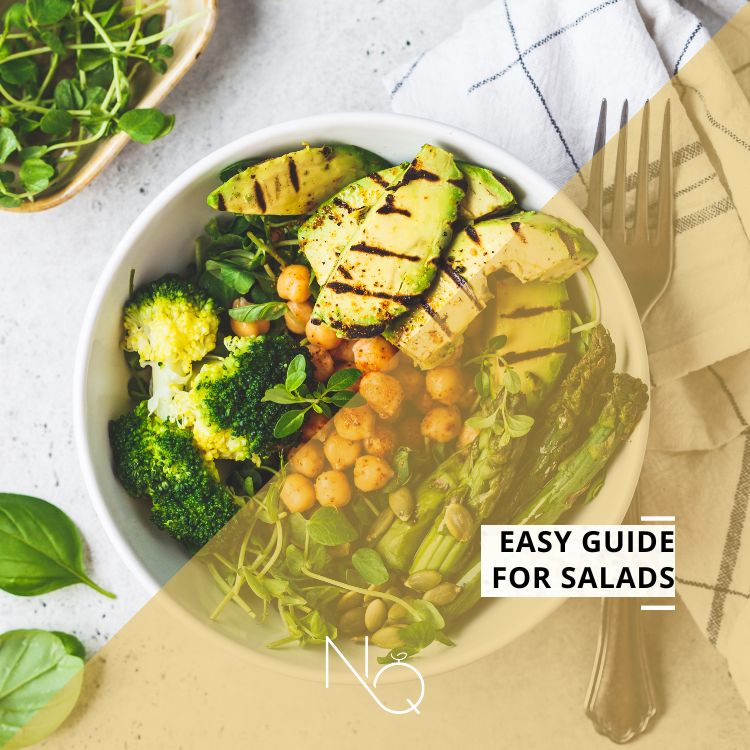This article can serve as your quick guide to easily find the ingredients to add to your salad to turn it into a complete meal. Just choose at least one option from each section and your salad is ready!
Source of Vegetables
The source of vegetables forms the base of the salad. We can choose one ingredient or more, depending on what is available. The variety in textures and colors will give superior nutritional and taste value to our salad. Options can include:
- Mixed greens (e.g., spinach, kale, arugula, lettuce)
- Peppers (red, yellow, green)
- Cucumbers
- Cherry tomatoes
- Grated carrots
- Broccoli bites
- Red cabbage
- Peas
- Radishes
- Kimchi
- Pickled food (e.g., Florina pepper, cucumbers, kritamos)
- Sliced strawberries
- Orange pieces
- Apple pieces
- Boiled beets
- Sautéed cabbage
- Boiled green beans
Source of Protein
The protein source can be either of plant or animal origin. Protein, as an ingredient, helps satiate us. So, adding 1 or 2 sources of protein to the salad will make it more filling. Options include:
- Grilled chicken breast strips
- Boiled eggs (sliced or chopped)
- Tofu cubes (baked or fried)
- Chickpeas (roasted or cooked)
- Red kidney beans (rinsed and drained)
- Salmon (grilled or canned)
- Τuna (grilled or canned)
- Edamame beans (steamed)
- Feta cheese (crumbled)
- Cottage cheese
- Anthotyro cheese
- Katiki cheese
- Grilled shrimps
- Tempeh
- Walnuts (chopped)
- Almonds (sliced)
- Hazelnuts (crushed)
Source of Carbohydrates
Finally, we need one more nutrient: carbohydrates. Carbohydrates complete the dish, creating a trio of foods so that we get maximum satisfaction from it since they lead to the production of serotonin in the brain (the hormone of joy). At the same time, carbohydrates are the ones that will supply us with immediate energy. Options include:
- Cooked quinoa
- Brown rice
- Sweet potatoes (baked or boiled)
- Whole grain pasta (cooked and cold)
- Corn (fresh or canned)
- Croutons (whole wheat)
- Whole grain crackers
- Oatmeal (cooked)
- Legume pasta (e.g., made of lentils, chickpeas)
- Potatoes (air fryer or boiled)
- Carob rusks
- Wholemeal rusks
Dressing
For our salad to be complete, and tasty we add some sauce that we can easily make. The options are, of course, limitless. Some examples:
- Balsamic vinaigrette: Olive oil, balsamic vinegar, mustard, melted garlic, salt, and pepper.
- Oregano vinaigrette: 2% yogurt, olive oil, lemon juice, oregano, salt.
- Tahini-lemon dressing: Tahini, lemon juice, water, chopped garlic, salt, and pepper.
- Yogurt sauce: 2% yogurt, olive oil, fresh dill, lemon juice, salt, and pepper.
- Mustard-honey dressing: mustard, honey, apple cider vinegar, olive oil, salt, and pepper.
- Linseed vinaigrette: Linseed oil, apple cider vinegar, honey, mustard, ground flaxseed, salt, and pepper.
- Orange-ginger dressing: Orange juice, ginger, soy sauce, sesame oil, honey, salt, and pepper.
- Avocado dressing: Avocado, lime juice, cilantro, garlic, olive oil, salt, and pepper.
As part of our nutrition education, these solutions are essential so we can begin implementing the habits we know will benefit us in our nutritional goals. Eating at least 5 portions of fruit and vegetables per day is a recommendation of the World Health Organization (WHO) to get the vitamins, trace elements, phytochemicals, water, and fiber we need. Vegetables have a multitude of beneficial effects: they contribute to a healthy weight, protect against cardiovascular disease, help reproductive function and the immune system, and much more. If you were interested in this topic, you can read more in the following articles:




